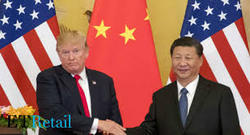US-China tariff ceasefire to reinstate dry bulk trade flows

In a much-anticipated working dinner in Buenos Aires following the G20 summit, United States and China agreed to a temporary tariff ceasefire. The agreement is expected to restore bulker trade flows and reinstate shipments which had come to a halt between the two nations.
The immediate restoration of grains and steel imports would induce longhaul shipments which is likely to boost tonne mile demand
THE truce in the US-China trade war should help restore trade flows in the bulker market, however all eyes are now on the pace of trade talks and how quickly the diplomatic de-escalation of tariffs can be translated into trade on the water.
The Americans have stressed a 90-day timeline for resolution of significant issues in the relationship, however specific questions of timelines are yet to be clarified from either side.
What we do know is that in that timeframe, the US will refrain from increasing tariffs on $200 billion in goods from 10% to 25% on January 1 as promised earlier.
In exchange, the Chinese will make substantial purchases of agriculture, energy and other industrial goods.
Bets could easily be taken now on whether or not the markets will return to the exact same spot at the end of the 90-day hiatus.
But as things stand now, the immediate restoration of grains and steel imports would induce longhaul shipments which is likely to boost tonne mile demand.
BIMCO’s chief shipping analyst Peter Sand said that there is almost no trade in agri bulks from the US to China – so any change to that small or large will be a move in the right direction.
China has switched its procurement of soyabeans away from the US due to the tariffs and has consolidated its dominance over Brazilian exports, displacing other buyers.
The US Department of Agriculture data shows that the US exports of soyabeans fell 43% year on year at 11.9m tonnes as of November 22. That equates to a loss of 122 panamax loads, or 183 supramax loads, from the market.
If China re-open its doors now, which is almost the midst of the peak US exporting season, there would certainly be some benefit to the dry bulk market.
However, this decision comes just weeks after China built up a large soybean stock, while at the same time its local demand has started to wain in the wake of an African swine fever epidemic spreading within the country’s significant pig industry.
“For the moment it looks as though in terms of effective demand generated for dry bulk vessels will take some time to seep through. With some slight benefits likely to be seen in mid late December,” Allied Shipbroking said in its latest report.
“Sentiment has taken a considerable hit and it looks as though it will take a fair bit of effort before we can see optimism re-emerge amongst most market participants.”
The optimistic tone struck by the two leaders is likely to reinstate US steel and aluminum imports from China which has reduced as local production ramps up and provide employment to bulker owners.
According to Stifel, the reduced US imports would have ripple effects throughout the supply chains as not only would less steel and aluminum potentially be moved, but that would also mean not as much iron ore, coking coal, and bauxite shipments into exporters like China and Japan.
Currently China imports a lot of coal from Indonesia which is barely six days away as against the US which is about 42 days away. If China starts importing from US that could result in a huge ton-mile increase in demand for dry bulk shipping, said Precious Shipping chief Khalid Hashim.